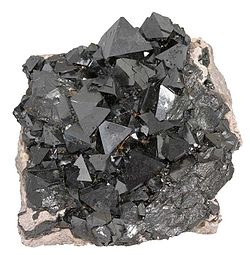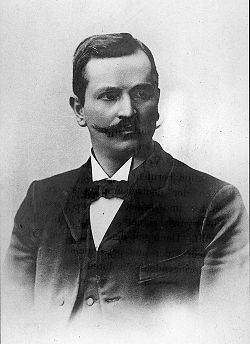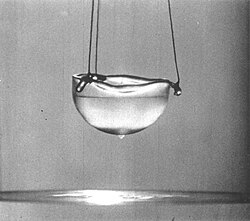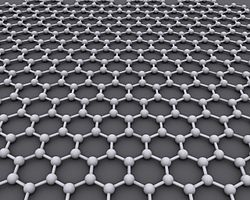Before quantum mechanics
Prehistory
- 28,000–12,000 BP – Upper Paleolithic: earliest evidence of ceramic objects made for ritual purposes. [2]
- 10,000–3300 BC – Neolithic: development of pottery, as well as early evidence of glass production and metalworking. [3]
- 3300–1200 BC – Bronze Age: development of metallurgy, with copper and tin being combined to create bronze. [4]
- 1200–300 BC – Iron Age: development of ferrous metallurgy, allowing iron and steel to largely replace bronze. [5]
Antiquity

- 8th century BC: first writings on the magnetic properties of lodestone in Ancient Greece. [6]
- 6th century BC – Thales of Miletus observes that rubbing fur on various substances, such as amber, would cause an attraction between the two, which is now known to be caused by static electricity. [7] [8]
- 5th century BC – Leucippus and Democritus postulate the philosophy of atomism. [9]
- 4th century BC – Aristotle describes the composition of matter in terms of the four classical elements, founding Aristotelian physics. [10]
- 1st century AD – Pliny the Elder in his Natural History records the story of Magnes the shepherd who discovered the magnetic properties of some iron stones. [6]
- 160 AD – Claudius Ptolemy writes his book Optics on reflection and refraction of light, and tabulated angles of refraction for several media. He found a refraction law valid for small angles. [11]
Classical theories before the 19th century
- 1611 – Johannes Kepler first states the Kepler conjecture about sphere packing in three-dimensional Euclidean space. It states that no arrangement of equally sized spheres filling space has a greater average density than that of the cubic close packing (face-centered cubic) and hexagonal close packing arrangements. [12]
- 1621 – Willebrord Snellius reformulates the laws of refraction and reflection of light into Snell's law. [13]
- 1660 – Robert Hooke postulates the simplest equation of linear elasticity known as Hooke's law. [14]
- 1687 – Isaac Newton postulates the Newton's laws of motion. [15]
- 1701 – Newton studies heat, leading to Newton's law of cooling. [16]
- 1729 – Scientist Stephen Gray discovers the electrical conduction of metals. [17]
- 1778 – Diamagnetism was first discovered when Anton Brugmans observed in 1778 that bismuth was repelled by magnetic fields. [18]
- 1781 – René Just Haüy (often termed the "Father of Modern Crystallography" [19] ) discovers that crystals always cleave along crystallographic planes. Based on this observation, and the fact that the inter-facial angles in each crystal species always have the same value, Haüy concluded that crystals must be periodic and composed of regularly arranged rows of tiny polyhedra (molécules intégrantes). This theory explained why all crystal planes are related by small rational numbers (the law of rational indices). [20] [21]
19th century

- 1800 – The Voltaic pile, the first electric battery is developed by Alessandro Volta. [22]
- 1803–1808 – John Dalton reconsiders the atomic theory of matter in order to understand chemistry. [23]
- 1816 – David Brewster discovers stress birefringence in diamond. [24]
- 1819 – Experimentally Pierre Louis Dulong and Alexis Thérèse Petit find that the specific heat capacity of solids was close to a constant value given by Dulong–Petit law. [25]
- 1821 – Thomas Johann Seebeck discovers the thermoelectric effect, related by the Seebeck coefficient. [26]
- 1822 – Joseph Fourier proposes Fourier's law of thermal conduction and the heat equation. [27]
- 1826 – Moritz Ludwig Frankenheim derives the 32 crystal classes by using the crystallographic restriction, consistent with Haüy's laws, that only 2, 3, 4 and 6-fold rotational axes are permitted. [28]
- 1827 – Georg Ohm, publishes the proportional relation between electric current and voltage in metals, known as Ohm's law. [29]
- 1834 – Jean-Charles Peltier discovers the Peltier effect: heating by an electric current at the junction of two different metals. [30]
- 1839 – William Hallowes Miller invents zonal relations by projecting the faces of a crystal upon the surface of a circumscribed sphere. Miller indices are defined which form a notation system in crystallography for planes in crystal (Bravais) lattices. [31]
- 1840 – James Prescott Joule formulates the equation for Joule heating quantifying the amount of heat produced in a circuit as proportional to the product of the time duration, the resistance, and the square of the current passing through it. [32]
- 1845 – Michael Faraday studies the interaction of light and magnetic fields with matter (Faraday rotation). [33]
- 1848 – Louis Pasteur discovers that sodium ammonium tartrate can crystallize in left- and right-handed forms and showed that the two forms can rotate polarized light in opposite directions. This was the first demonstration of molecular chirality, and also the first explanation of isomerism. [34]
- 1850 – Auguste Bravais develops the concept of Bravais lattices to describe periodicity in crystals. He derives the 14 space lattices. [35]
- 1853 – Discovery of Wiedemann–Franz law relating thermal and electrical conductivities, by Gustav Wiedemann and Rudolph Franz. [36]
- 1854 – Lord Kelvin discovers the thermoelectric Thomson effect. [37]
- 1859 – Gustav Kirchhoff introduces the concept of a blackbody and proves that its emission spectrum depends only on its temperature. [38]
- 1861–1865 – James Clerk Maxwell summarizes the fundamental equations of electromagnetism into an early version of Maxwell's equations and relates electromagnetism to light in his publications On Physical Lines of Force and A Dynamical Theory of the Electromagnetic Field . [39]
- 1867 – Dmitry Chernov establishes the critical temperatures of steel. [40]
- 1872 – The Boltzmann transport equation, describing the statistical behaviour of a thermodynamic system not in a state of equilibrium, is devised by Ludwig Boltzmann. [41]
- 1872 – Ludvig Lorenz finds the Lorenz number, the constant of the Wiedemann–Franz law. [42]
- 1874 – Karl Ferdinand Braun discovered current rectification using a point-contact metal–semiconductor junction. [43]
- 1875 – John Kerr discovers the double refraction of solid and liquids, now known as the Kerr effect. [44]
- 1876 – Josiah Willard Gibbs introduces the concept of phase transition. [40]
- 1879 – Edwin Hall discovers the Hall effect. [45]
- 1879 – Leonhard Sohncke lists the 65 crystallographic point systems using rotations and reflections in addition to translations. [46]
- 1880 – The first demonstration of the direct piezoelectric effect by the brothers Pierre Curie and Jacques Curie. [47]
- 1883 – Thomas Edison discovers thermionic emission or the Edison effect. [48]
- 1887 – Floris Osmond names the phases of steel. [40]
- 1887 – Heinrich Hertz discovers the photoelectric effect. [49]
- 1888–1889 – Crystalline optical properties of liquid crystals and their ability to flow are first described by Friedrich Reinitzer and confirmed by Otto Lehmann. [50]
- 1891 – Derivation of the 230 space groups (by adding mirror-image symmetry to Sohncke's work) by a collaborative effort of Evgraf Fedorov and Arthur Schoenflies. [51] [52]
- 1895 – Wilhelm Conrad Röntgen discovers X-rays in experiments with electron beams in plasma. [38]
- 1895 – Hendrik Lorentz derives the Lorentz force for charged particles in electric and magnetic fields. [53]
- 1895 – Pierre Curie discovers empirically that the magnetic susceptibility of many materials is inversely proportional to temperature according to Curie's law. He also found that permanent magnetism was lost after a certain Curie temperature. [6]
- 1896–1897 – Pieter Zeeman first observes the Zeeman splitting effect by applying a magnetic field to light sources. [54]
- 1897 – J. J. Thomson's experimentation with cathode rays led him to suggest a fundamental unit more than a 1000 times smaller than an atom, based on the high charge-to-mass ratio. He called the particle a "corpuscle", but later scientists preferred the term electron. [55]


